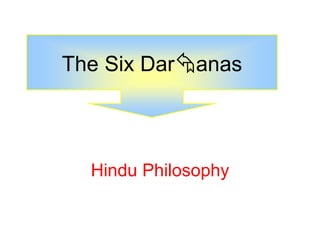
cupdf.com_hindu-philosophy-56bda1d26046e.ppt
- 1. Hindu Philosophy The Six Daranas
- 2. • Indian philosophy is a practical instrument designed to fathom the conditions of the life process • The principal topics are bondage and freedom, in part due to the prevalence of the doctrines of transmigration and karman- Purpose
- 3. Questions To Be Answered • Why is there suffering in the world? • What is the nature of the human person? • What is the nature of the world in which he lives? • What is the proper method of living in the light of one’s knowledge of himself, the world, and the Supreme Being?
- 4. • All religions and philosophies abide by conceptual maps designed to explain these questions and to help individuals cope with the chaotic forces surrounding them • Answers to Why? What? How? Prevent despair, fatalism, and mental anguish Conceptual Maps
- 5. • That which provides system, order to the myriad facts bombarding the mind revolve around – Bondage – Transmigration (sasra-) – Karman- – Freedom The Map
- 6. • It was in these dialogues that this map was first introduced • From the Upaniads it entered later Indian schools and sects • To a degree, it applies to heterodox as well as orthodox schools • The only difference between the two is the means of arriving a the end. The Upaniads
- 7. • All schools—orthodox and heterodox— sought after the same goal: – A vision (darana-) of truth (tattva) concerning the individual, the world and the Supreme Darana
- 8. • Truth sets one free: free from all the entanglements of this world – Sayag-darana-sampanna karmabhir na nibadhyate; daranena vihnastu sasra pratipadyate – [‘He who possesses the correct vision is not bound down by (his) actions; indeed, he who is devoid of that vision is drawn into the vortex of life and death (sasra- )] Truth
- 9. • The search for truth led to the formation of a method of philosophical discussion. • With this method comes the intellectual, logical, metaphysical, epistemological and ethical arenas emphasized in all philosophical systems • Important also is the understanding of other schools and opinions. Philosophical Method
- 10. • These were closely investigated. Thus, – A philosopher would first state his opponent’s case (known as the prva-paka or “prior view” – Followed by refutation (khaana) – Finally, a statement and proof of the philosopher’s own position (= “subsequent view: uttara-paka or conclusion: siddhnta) Rival Positions
- 11. • All schools of Indian philosophy are listed as stika “those who accept the authority of the Veda” or nstika “those who don’t accept the authority of the Veda” • The first are orthodox (hence Hindu); the latter are heterodox The Hindu Daranas
- 12. • Vednta (Uttara-Mms; Jna- Mms): Bdaryaa • Mms(Prva-Mms; Mms): Jaimini • Yoga: Patajali • Skhya: varaka • Nyya: Gautama • Vaieika: Kada stika Schools
- 13. • These are the six traditional schools • Other schools also exist, such as – Pinya (Grammarian) School – Rasevara (Medical) School Both are mentioned in the Sarva-Darana Sagraha of Mdhavcrya The Six Daranas
- 14. • Crvka ‘Materialist School’ • Bauddha ‘Buddhist School’ • Jaina (the school of the Jinas or the Conquerors) Nstika Schools
- 15. Schema
- 16. • Directly based upon the Dharma Stras and -stras, the Kalpa Sutras, Brhmaas, and Sahits • One purpose of the school was to systematize the ritual performances in these Vedic Works Prva-Mms
- 17. • Emphasized the speculative approach and so derived its main inspiration from the Upaniads Uttara-Mms
- 18. • Skhya, Yoga, Nyya, Vaieika are all based on experience and reason • All are in harmony with the Veda • The Bauddha, Jaina, Crvka, however, do not attempt to harmonize the Veda with experience and reason The Other Daranas
- 19. • Ordinary, normal experience, i.e. those findings brought about by intellectualizing on the sense data presented to the brain, is wholly accepted by the Nyya, Vaieika, Skhya, and Crvka Intellection
- 20. • The teacher’s authority or testimony of qualified persons and scriptures are other primary means of knowledge followed by the Vednta and Mms. • Direct realization (darana or sktkra-) is also widely accepted by many schools. The Teacher
- 21. • Two traditions exist in India: – The oral – The written Of the two, the oral is more highly regarded. It is more effective and prestigious to receive the tradition or sacred knowledge from the mouth of the teacher rather than from books. Sources of the Schools
- 22. • This is the best and , to many, the only way that knowledge is to be acquired. • The Veda is the prime example of the oral tradition. Bauddha, Jaina, and other schools also belong to this category • As a result the teacher as the bearer and preserver of sacred knowledge was highly venerated Oral Tradition
- 23. • Introduced with the classical daranas. • It is probable that the Indian writing systems came from a Semitic script and that it began to take hold from the 3rd century B.C.E. in inscriptions. • The script that we commonly see today is devangar, which assumed its characteristic shape in the 7th or 8th c. C.E. with the presence of inscriptions. Written Tradition